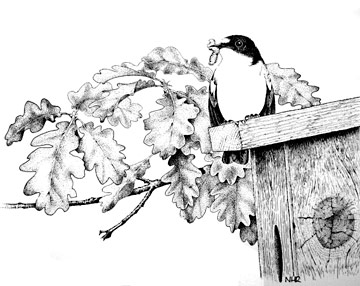Pied Flycatcher (Ficedula hypoleuca)

Pied Flycatcher © Norman Richardson
Pied Flycatchers are mostly birds of the upland deciduous woods in parts of western and northern Britain, and, as expected, almost all of the habitat codes included broadleaved woodland. With such preferences, they are never likely to form a major part of the county avifauna, but during the 1990s they seemed to be colonising Cheshire and Wirral more widely. The number of occupied tetrads with confirmed or probable breeding has doubled in the last twenty years: 23 now and 11 in the First Atlas. Their distribution has shifted, however, and only four of the eleven from 1978-84 are still occupied now. Most of the county’s Pied Flycatcher nests are in boxes and are regularly studied, natural sites – often holes bored by Great Spotted Woodpeckers in the previous year – now being unusual. This is probably a good choice for the birds because nests in natural holes suffer much higher predation than those in nest-boxes (Lundberg & Alatalo 1992).
Pied Flycatchers winter in west Africa south of the Sahara, in wooded areas on the edge of the savannah and climax forest, with British birds probably from Guinea across to Ghana. Birds usually arrive in the county around the third week of April, the males arriving first and setting up territory around a suitable nest-hole. Their weak song is not well-known to all observers and possibly some singing males could have been overlooked. The normal clutch is of 7 pale blue eggs, which hatch around the end of May in lowland Cheshire. Despite their name, adult Pied Flycatchers eat more ants than anything else, with other hymenoptera (bees, wasps, and sawflies) and coleoptera (beetles). On the other hand, most of the food that they bring to their chicks is caterpillars and the larval stages of invertebrates, gleaned from leaves in the tree-canopy. In some years they struggle to find sufficient food for all of the chicks. This species may well be suffering from climate change, which is advancing the peak period of food availability for Pied Flycatchers in deciduous forests, whilst in the Netherlands the birds have so far been unable to compensate by breeding earlier (Both et al. 2006).
At the end of the First Atlas period, the county population was estimated at 10-15 pairs, the highest level since records began, probably occasioned by a surge in numbers in 1984 (Richards 1997). The population has clearly risen since then, although the picture is clouded by the provision of more nestboxes. According to the annual county bird reports, the total stayed at roughly the 1984 level throughout the 1980s, then ‘larger than usual numbers’ were reported in 1990 and the county population reached a new plateau during the 1990s, with annual figures of 46-64 males at 16-23 sites, and exceptional totals of 74 males at 25 sites in 1999. This was followed by a crash to 35 males at 14 sites in 2000. There was no apparent drop in the national population index between those two years, and the fall must be ascribed to unknown factors, but it affected most localities in the county, widely-spaced from each other: Pied Flycatchers bred on Wirral from about 1989 to 1999 but not since. From 2000 to 2003, the Cheshire total was recorded as 30-43 males at 12-18 sites. All of these figures are of ‘males’, as detailed in Cheshire and Wirral bird reports, rather than breeding pairs: some birds hold two territories and others, pioneer prospectors for new sites, do not succeed in attracting a mate. Many of the ‘possible’ breeding records on the distribution map were likely to have been male birds on passage.
The populations in the south Pennines and in north Wales expanded during the 1980s and 1990s, perhaps fuelling the rise in our county population. Some birds wander quite widely, such as the female that bred in Powys one year then in Delamere Forest the next year. On the other hand, some birds show strong site fidelity: one female ringed in Delamere Forest bred there in 1992, 1993, 1994 and 1996, using the same nest-box in the first two years.
The comprehensive fieldwork for this Atlas uncovered a few more birds than previously, but it is still a scarce species in Cheshire, and has not reoccupied any Wirral site. Most Cheshire birds are along the Sandstone ridge or in the eastern hills. The 2005 Cheshire and Wirral Bird Report detailed 46 known nesting or territory-holding birds, and during this Atlas period there are likely to have been around 50-60 pairs of Pied Flycatchers breeding in the county.
Sponsored by Clive Richards

